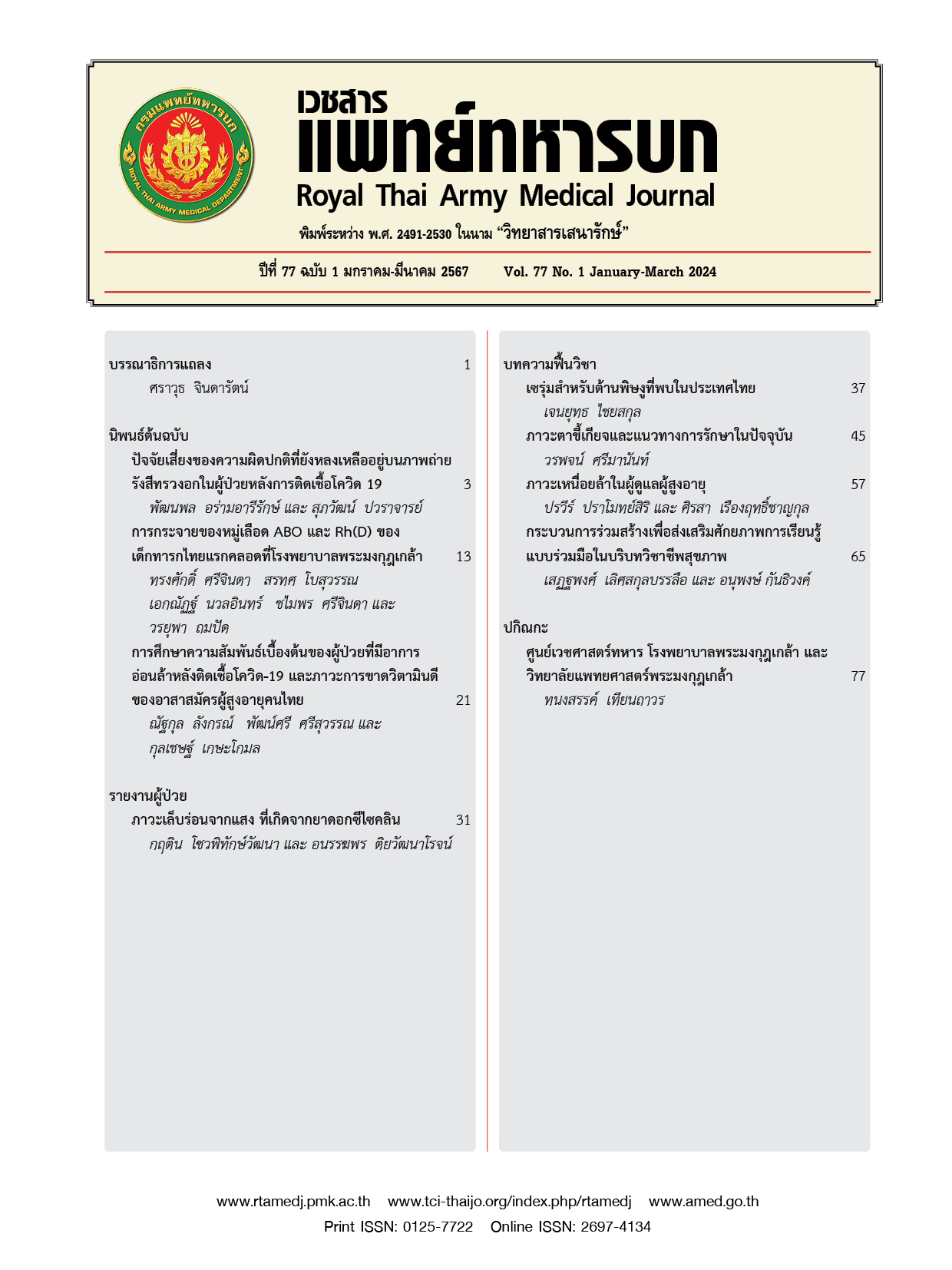เซรุ่มสำหรับต้านพิษงูที่พบในประเทศไทย
Main Article Content
Downloads
Article Details

อนุญาตภายใต้เงื่อนไข Creative Commons Attribution-NonCommercial-NoDerivatives 4.0 International License.
บทความในวารสารนี้อยู่ภายใต้ลิขสิทธิ์ของ กรมแพทย์ทหารบก และเผยแพร่ภายใต้สัญญาอนุญาต Creative Commons Attribution-NonCommercial-NoDerivatives 4.0 International (CC BY-NC-ND 4.0)
ท่านสามารถอ่านและใช้งานเพื่อวัตถุประสงค์ทางการศึกษา และทางวิชาการ เช่น การสอน การวิจัย หรือการอ้างอิง โดยต้องให้เครดิตอย่างเหมาะสมแก่ผู้เขียนและวารสาร
ห้ามใช้หรือแก้ไขบทความโดยไม่ได้รับอนุญาต
ข้อความที่ปรากฏในบทความเป็นความคิดเห็นของผู้เขียนเท่านั้น
ผู้เขียนเป็นผู้รับผิดชอบต่อเนื้อหาและความถูกต้องของบทความของตนอย่างเต็มที่
การนำบทความไปเผยแพร่ซ้ำในรูปแบบสาธารณะอื่นใด ต้องได้รับอนุญาตจากวารสาร
เอกสารอ้างอิง
Chippaux JP. Snakebite envenomation turns again into a neglected tropical disease! J Venom Anim Toxins Incl Trop Dis. 2017;23:38.
WHO. Snakebite envenoming [Internet]. 2023 [cited 2023 Dec 8]. Available from : https://www.who.int/health-topics/snakebite#tab=tab_1
Kasturiratne A, Wickremasinghe AR, de Silva N, Gunawardena NK, Pathmeswaran A, Premaratna R, et al. The global burden of snakebite: a literature analysis and modelling based on regional estimates of envenoming and deaths. PLoS Med. 2008;5(11):e218.
Chaisakul J, Rusmili MR, Hodgson WC, Hatthachote P, Suwan K, Inchan A, et al. A Pharmacological Examination of the Cardiovascular Effects of Malayan Krait (Bungarus candidus) Venoms. Toxins (Basel). 2017;9(4):122.
Charoenpitakchai M, Wiwatwarayos K, Jaisupa N, Rusmili MRA, Mangmool S, Hodgson WC, et al. Non-neurotoxic activity of Malayan krait (Bungarus candidus) venom from Thailand. J Venom Anim Toxins Incl Trop Dis. 2018;24:9.
Chaisakul J, Alsolaiss J, Charoenpitakchai M, Wiwatwarayos K, Sookprasert N, Harrison RA, et al. Evaluation of the geographical utility of Eastern Russell’s viper (Daboia siamensis) antivenom from Thailand and an assessment of its protective effects against venom-induced nephrotoxicity. PLoS Negl Trop Dis. 2019;13(10):e0007338.
Khimmaktong W, Nuanyaem N, Lorthong N, Hodgson WC, Chaisakul J. Histopathological Changes in the Liver, Heart and Kidneys Following Malayan Pit Viper (Calloselasma rhodostoma) Envenoming and the Neutralising Effects of Hemato Polyvalent Snake Antivenom. Toxins (Basel). 2022;14(9):601.
Chaisakul J, Konstantakopoulos N, Smith AI, Hodgson WC. Isolation and characterisation of P-EPTX-Ap1a and P-EPTX-Ar1a: pre-synaptic neurotoxins from the venom of the northern (Acanthophis praelongus) and Irian Jayan (Acanthophis rugosus) death adders. Biochem Pharmacol. 2010;80(6):895-902.
Das RR, Sankar J, Dev N. High-dose versus low-dose antivenom in the treatment of poisonous snake bites: A systematic review. Indian J Crit Care Med. 2015;19(6):340-9.
Chaisakul J, Rusmili MRA, Alsolaiss J, Albulescu LO, Harrison RA, Othman I, et al. In Vitro Immunological Cross-Reactivity of Thai Polyvalent and Monovalent Antivenoms with Asian Viper Venoms. Toxins (Basel). 2020;12(12):766.
Lertsakulbunlue S, Suebtuam R, Eamchotchawalit T, Chantkran W, Chaisakul J. Clinical Profile and Pharmacological Management of Snakebites in Community Care Units: A Retrospective Study Using Two Military Hospital Databases in South Thailand. Trop Med Infect Dis. 2023;8(7):346.
WHO. Guidelines for the management of Snake-Bites. 2nd ed. Genewa : WHO; 2016.
Rojnuckarin P, Suteparak S, Sibunruang, S. Diagnosis and management of venomous snakebites in Southeast Asia. Asian Biomedicine. 2012;6(6):795-805.
Morais V. Antivenom therapy: efficacy of premedication for the prevention of adverse reactions. J Venom Anim Toxins Incl Trop Dis. 2018;24:7.


